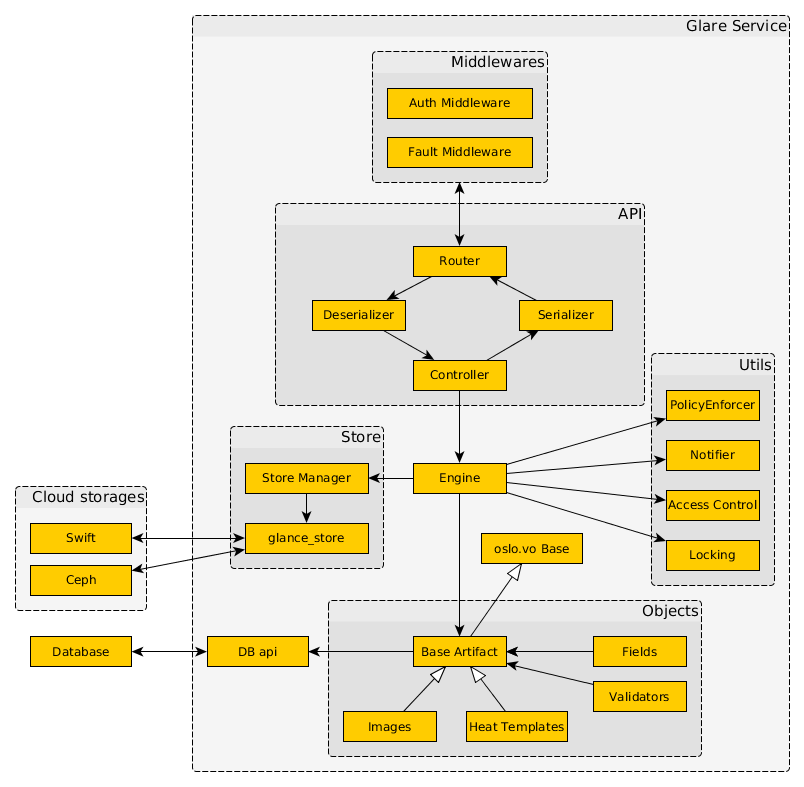4.7 KiB
Basic architecture
OpenStack Glare has a client-server architecture that provides a Unified REST API, which then transfers control to the appropriate artifact type. The API consists of * Router, that converts WSGI requests into appropriate Glare API methods; * Deserializer, that parses parameters from user input and performs initial validation checks; * Controller, which is responsible for interactions with Glare Engine; * Serializer, that prepares information for responses (inserts status code, content-type, response content length, and so on).
But before the requests reach the API they have to pass trough the set of middlewares, and each performs some actions over Request or Response objects. For example, Auth middleware checks that authentication token provided in request header is valid by sending auth requests to Identity service, obtains user information and injects it in Request object as a context objects; Fault middleware, on the other hand, is responsible for converting inner Glare exceptions to appropriate http error codes.
Almost all business logic is provided by Glare Engine. It is responsible for Policy checking, when operator may define what operations users may execute, based on their contexts; for sending broadcast Notifications about performed actions; then it is Access Control, when Engine checks if user has rights to modify desired artifact; and finally – Locking, that is used to prevent race conditions during artifact updates, when the artifact is locked until the modification operation is finished.
All the file (Blob data) operations are performed using glance_store library, which is responsible for interaction with external storage back ends and (or) local filesystem(s). The glance_store library provides a uniform interface to access the backend stores. Also there is an adapter layer Store Manager between Engine and glance_store that is responsible for converting glance_store exceptions and adding some additional logic, like sha256 calculation.
All database operations are organized with artifact types. Each type installed in the system must implement Glare Artifact Type Interface (GATI) and use appropriate data types to describe its attributes.
Glare uses several data types from a declarative framework oslo.versionedobjects: Integer, Float, String, Boolean, which complemented with the following home-grown data types: * Version — specifies the version of the artifact in ‘SemVer’ format and implements comparison operations. * Dependency — sets a reference to another artifact. At the request of the ‘dependency’ field, Glare will get the dependent artifact meta-information. * Blob — specifies a binary object. When a user assigns a value to this field, data will be automatically redirected to one of the connected storages. * List and Dict — define complex data structures such as Lists and Dictionaries of primitive types respectively.
Base artifact type is an abstract class that has a reference implementation of GATI. It contains only common fields, like "id", "name", "version", "created_at”, "owner", and so on.
Each artifact type is inherited from the Base and adds some additional fields. For example, for Image artifact type there were added "container_format" and "disk_format" string fields, for Heat Template it was "nested_templates" Blob Dictionary.
Validators are objects that can be attached to a filed to perform additional checks. For example, if validator MinLen(1) is attached to a string field it checks that the string value is non empty. Validator ForbiddenChars("/", ",") validates that there shouldn't be slashes and commas in the string.
Glare uses a central Database that is shared amongst all the components in the system and is sql-based by default. Other types of database backends are somewhat supported and used by operators but are not extensively tested upstream.

Image 1. OpenStack Glare Architecture